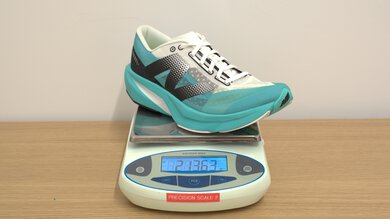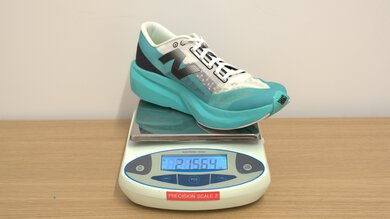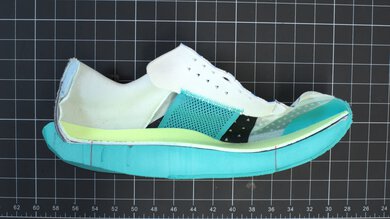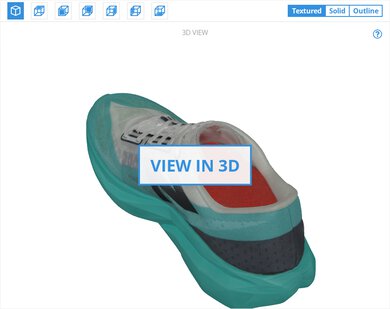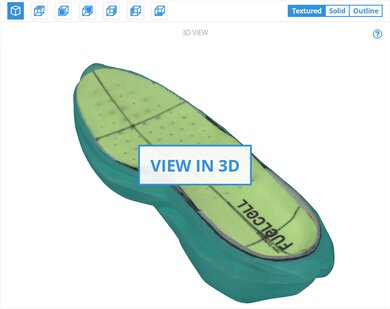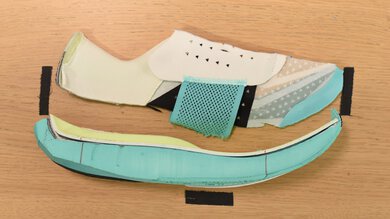The New Balance FuelCell Rebel v4 brings some serious updates to an already well-loved running shoe. A wide base underfoot and a relatively low stack provide amazing stability, while the lightweight design keeps things nimble—though not quite race-day fast. Now featuring a PEBA-EVA blend midsole, the shoe offers some responsiveness, but it's really ideal for daily training, from easy miles to moderately paced runs. The upper strikes a balance between breathability and structure, making the Rebel v4 a comfortable and reliable option for daily training.
Our Verdict
The New Balance FuelCell Rebel v4 isn't bad for marathon distances, particularly if you're after a lightweight shoe with reliable stability. The shoe's lower energy return and insufficient underfoot protection lower its potential for top-tier marathon performances. It's far from a dedicated racing machine, but it could be an acceptable option for non-competitive runners looking to prioritize stability.
-
Great stability.
-
Lightweight.
The New Balance FuelCell Rebel v4 performs decently for shorter distances thanks to its relatively lightweight build. While the shoe's firm forefoot helps, the responsiveness is still too low to help you push off efficiently during faster, shorter races.
-
Lightweight.
-
Energy return is too low for racing.
The New Balance FuelCell Rebel v4's midsole offers moderate energy return. While you'll still get some bounce, it lacks the dynamic propulsion top-tier racing shoes offer.
-
Provides decent bounce for a daily trainer.
-
Energy return is too low for racing.
The New Balance FuelCell Rebel v4 delivers adequate cushioning, providing protection, especially at the heel. However, the forefoot cushioning is somewhat lacking, making it less suitable for runners who prefer plush landings during extended training sessions. Because it's lower stacked, it will bottom out faster than more protective alternatives.
-
Heel cushioning is quite good.
-
Not enough underfoot protection, especially in the forefoot.
The New Balance FuelCell Rebel v4 offers impressive lateral stability, making it an excellent choice for runners needing confidence and security. Its very wide outsole platform and lower stack height provide great ground contact, helping the shoe maintain a steady balance for runners who prioritize stability.
-
Super wide base makes for a stable platform.
-
Lower stack makes for a grounded ride.
-
Midsole is firm.
- 6.4 Marathon Racing
- 7.3 5K/10K Racing
Performance Usages
- 6.2 Energy Return
- 6.7 Cushioning
- 8.4 Lateral Stability
Changelog
- Updated Apr 02, 2025: Converted to Test Bench 0.8.
- Updated Apr 02, 2025: Review published.
Check Price
Differences Between Sizes And Variants
We tested the New Balance FuelCell Rebel v4 in men's US size 9, as indicated on the label. The color shown here is Cyber Jade with White and Black, but the shoe is available in other colorways, including White with Bleached Lime Glo and Hot Mango, White with Linen and Sea Salt, and Black with Graphite and White. Wide versions are offered separately for both men (2E) and women (D).
Compared To Other Running Shoes
The New Balance FuelCell Rebel v4 is a lightweight daily trainer designed for runners who appreciate a wide platform that's close to the ground. It caters well to those who need extra stability on their shorter daily mileage. However, runners seeking maximum cushioning and comfort for their daily training might find alternatives like the Mizuno Neo Zen more enjoyable for long-distance comfort. If your priority is shaving grams, the Brooks Hyperion 2 is a lighter daily trainer, but this comes at a cost: less cushioning and less stability than the Rebel v4. If you require lateral stability and are after more support to correct overpronation, the ASICS GEL-KAYANO 31 is where to look.
Within New Balance's performance-oriented FuelCell lineup, the Rebel v4 is positioned above the New Balance FuelCell Pvlse v1, which serves as their minimalist trainer, but below the more cushioned and plated New Balance FuelCell SuperComp Elite v4, which is their racing super shoe.
For more options, check out our recommendations for the best running shoes to find the perfect pair.
The New Balance FuelCell Rebel v4 and the ASICS NOVABLAST 5 are both daily trainers, but they cater to different running preferences. The New Balance offers a classic daily trainer feel with a firmer midsole and a more grounded, stable ride. On the other hand, the ASICS is significantly more cushioned, providing better underfoot protection, which is especially beneficial during longer runs or for those who prioritize softness and comfort. While both shoes are reliable choices for daily training, choose the Rebel v4 if you prefer a stable, firm feel and the NOVABLAST 5 if you want maximum cushioning and comfort over extended distances.
The HOKA Mach 6 and New Balance FuelCell Rebel v4 are both lightweight daily trainers, ideal for runners who prefer a more nimble feel. The Rebel v4 is the lighter of the two, offering a more grounded and stable ride that feels secure underfoot. The Mach 6, while slightly heavier, delivers a more dynamic experience with a bit more bounce, making it feel livelier during runs.
The Brooks Hyperion 2 and the New Balance FuelCell Rebel v4 are both relatively lightweight, low-stack daily trainers. They perform very similarly overall, but the New Balance offers slightly better cushioning and more efficient energy return, making it the better-value option for most runners.
The New Balance FuelCell Rebel v4 and New Balance FuelCell SuperComp Elite v4 share similar names and designs—but don't let that fool you, as they're fundamentally different shoes. The Rebel v4 is a versatile low-stack daily trainer, offering stability ideal for everyday miles. The SuperComp Elite v4, however, is a specialized racing shoe featuring a carbon plate and higher energy return, providing a more aggressive ride for peak performance on race day.
For most runners, the New Balance FuelCell Rebel v4 has some advantages over the ASICS GEL-KAYANO 31. It's a significantly lighter shoe that feels well-cushioned despite having a much lower stack height than the GEL-KAYANO. Thanks to its more responsive foam, it's a bit more efficient and better at picking up the pace. The GEL-KAYANO is still a better fit for runners who prefer higher stacks or need a stability shoe.
The New Balance FuelCell Rebel v4 and On Cloudmonster 2 are both daily trainers, but each appeal to different tastes. The Rebel v4 offers a lighter, firmer, and closer to the ground experience. In contrast, the Cloudmonster 2 provides more substantial cushioning, making it a better choice if you prioritize protection on slower runs.
The New Balance FuelCell Rebel v4 and the Saucony Triumph 22 both cater to daily training needs, but their focus differs. The New Balance offers greater lateral stability, which benefits runners seeking a more grounded ride. The Saucony delivers a more cushioned ride, making it an option for those prioritizing impact absorption.
Test Results
The New Balance FuelCell Rebel v4's heel energy return is mediocre, offering only a modest sense of bounce and responsiveness. Runners won't experience a particularly energetic ride at heel strike, meaning the shoe doesn't significantly aid propulsion from the heel. This makes it better suited for runners who rely less on pronounced heel-to-toe transitions.
Similarly, the forefoot energy return in this shoe remains mediocre, providing only moderate responsiveness upon toe-off. While there's some decent bounce for a daily trainer, the model lacks the dynamic pop sought by competitive runners in faster, more aggressive workouts or races.
The shoe initially feels adequately cushioned at the heel, providing comfortable landings, especially during shorter to moderate runs. However, hands-on testing revealed issues over extended distances. Due to its softer midsole compound, the cushioning noticeably compresses after roughly nine miles (15 km), partially bottoming out and significantly reducing its effectiveness. Consequently, runners looking to tackle longer distances or sustained mileage may find it disappointingly insufficient over time.
The New Balance FuelCell Rebel v4's forefoot cushioning feels underwhelming. Practical testing uncovered significant drawbacks over longer distances, where the midsole foam noticeably collapses in the forefoot region, bottoming out and compromising comfort and protection.
The midsole is on the firmer side, but it's not overly stiff, either. This balance helps maintain steady and efficient landings, which is especially useful on longer or uneven routes where consistent stability matters.
The forefoot foam of this shoe is very firm, delivering a highly stable and consistent feel across various intensities and paces. This contributes notably to excellent ground feedback and enhanced stability. However, this model might feel overly firm for runners who prefer a softer feel in the forefoot.
Check Price
Comments
New Balance FuelCell Rebel v4: Main Discussion
Let us know why you want us to review the product here, or encourage others to vote for this product.
This product has been merged with New Balance Men’s FuelCell Rebel V4 Running Shoe, Hot Man. Follow the discussion here.


